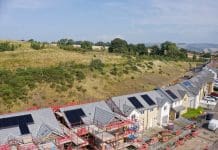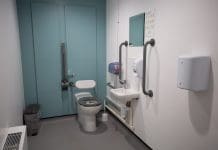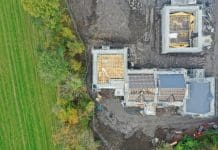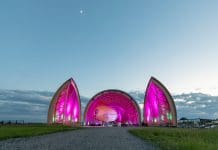Working with Arup and local communities, LLDC has launched ‘Creating Places That Work for Women and Girls’, a Handbook for Local Authorities, Developers and Designers
The London Legacy Development Corporation (LLDC), supported by global sustainable development and engineering consultancy Arup, have launched a new handbook to ensure that places are designed to be equitable for everyone, including women and girls.
The handbook is the result of extensive consultation and research to address gender biases embedded in the traditional practice of urban design and planning where the needs of women and girls were frequently not considered.
Three years of dedicated research has gone into the handbook
LLDC is the first Local Planning Authority in the UK to publish guidelines and, since 2021, has been pioneering gender-informed design and planning.
The knowledge and good practice have now been compiled into a handbook providing practical steps that urban planners, developers, architects, and other stakeholders can take to ensure a gender-informed approach is applied in the planning, design and decision-making process, from the inception of any project through to delivery and long-term management.
The handbook has been directly informed by robust local evidence, gathering, testing and, more importantly, directly co-created with a diverse group of local women and girls and local stakeholders. The work was also shaped by emerging national and international studies and approaches. LLDC collaborated with gender equity experts, as well as others who are leading research and campaigning in this field such as Make Space for Girls and UN Habitat.
Key recommendations to incorporate women and girls’ safety in design include:
- Establishing clear organisational commitments for implementation of gender-inclusive processes in all projects and decisions.
- Adopting mechanisms and governance frameworks to ensure continuity of these commitments and their effective delivery.
- Informing decisions, strategies, and designs based on a genuine understanding of women’s and girls’ lived experiences through participatory-led approaches. This requires multi-stage data gathering, from evidence-based research to local knowledge acquisition at a project-specific level.
- Adopting a holistic approach, with cross-boundary and cross-sector collaboration with key stakeholders, including education, social services, and policing.
- Measuring impact and successes to collect data aiding the identification of lessons learned, patterns, emerging trends, and good precedents.
Creating a safer, healthier public realm for all
Designing cities and places that cater to women and girls will make public realm safer, healthier, and more equitable for everyone.
This can ensure fair access to services and opportunities, thereby advancing the socio-economic mobility of women and girls.
This will not only improve, protect, and empower the lives of women and girls but will also unlock the full potential of both our public realm and individual developments to influence wider issues such as climate change mitigation, sustainable development, and economic growth.
The involvement of women and girls throughout the process has been integral
Research and practice have shown that the most effective way to design places that work for women and girls is to engage them in the decision-making and design processes. The handbook outlines planning processes that LLDC has been practicing ensuring the lived experiences of women and girls are directly incorporated into decision-making and development.
Including their perspectives through genuine participatory-led engagement methods such as exploratory walks, co-design and co-clienting ensures that any decision or intervention in the built environment directly responds to the needs of the community and is context specific.
The direct benefits of applying a gender-informed approach are already beginning to be realised. For example, the emerging knowledge on the topic has influenced the redesign of the Waterden Green Play Area on the Park, a green space dedicated to teenagers, to ensure that the area is inclusive and welcome for teenage girls. LLDC worked closely with local girls and young women to develop a co-client relationship, ensuring them the ability to influence the project brief and selection of a design team.
The handbook is dedicated to the late Pam Alexander OBE
Marina Milosev, LLDC’s principal planning officer, said: “We need to change how we design our cities, particularly for women and girls. If we are to create places that are inclusive for all then we must involve women and girls in the decision-making and design processes.
“This requires a long-term commitment to adopting planning policies and development processes that will lead to inclusive, healthy, child-friendly, and socially prosperous environments that feel safer for everyone. It will improve, protect, and empower the lives of women and girls while enhancing cities’ potential to address climate change, sustainable development, and economic growth.”
Mei-Yee Man Oram, access and inclusive environments operational leader at Arup, added: “This work has been directly shaped by and co-designed in partnership with a diverse group of local women and girls and gender diverse people who we wish to send sincere gratitude for providing their expertise and sharing their personal experiences.
“For too long, the role that the built environment plays in the safety and inclusion of women, girls and gender diverse people has been a secondary concern.”
“Building and developing places guided by principles that explore different people’s experiences and perspectives is an important shift as we strive to create more positive spaces for all.”
Arup previously collaborated with LLDC to produce a consultation report which provided the evidence base to inform the new guidance and any work that the LLDC, or its subsequent planning authorities, may undertake in the future.
This included the preparation of supplementary planning documents and design guidelines, future planning policies, regeneration initiatives and masterplan solutions.








![[VIDEO] Local planning inspector recruitment to begin in earnest in new year A drive to recruit local planning inspectors will begin in the new year](https://www.pbctoday.co.uk/news/wp-content/uploads/2025/12/iStock-2159482095-2-218x150.jpg)




![[VIDEO]Government launches new online appeal service for local planning authorities Group of young coworkers using computers in their group office, representing the new online appeals service](https://www.pbctoday.co.uk/news/wp-content/uploads/2025/12/iStock-2191280160-218x150.jpg)
